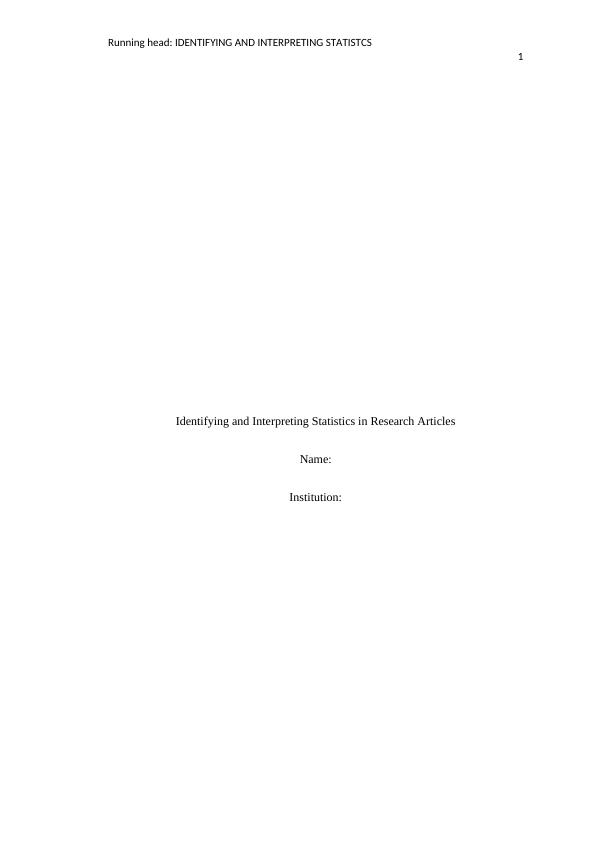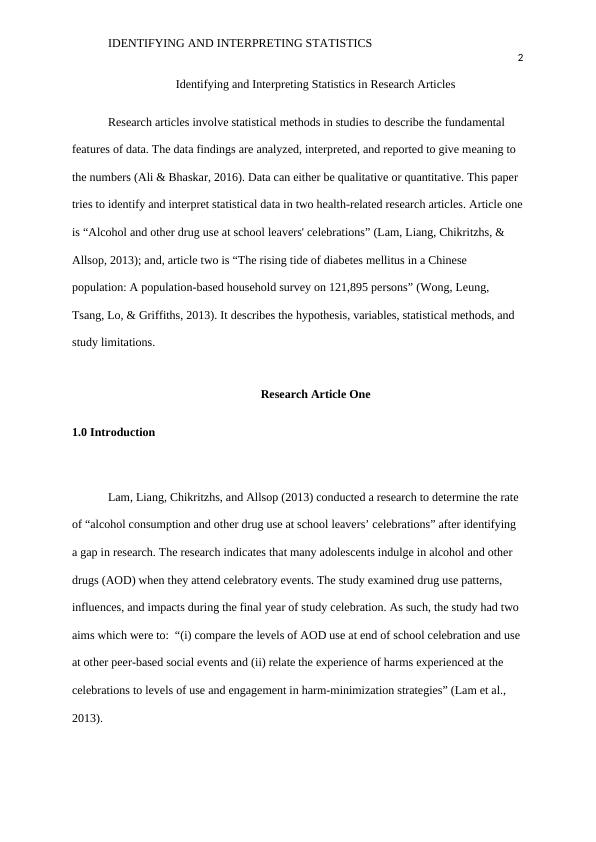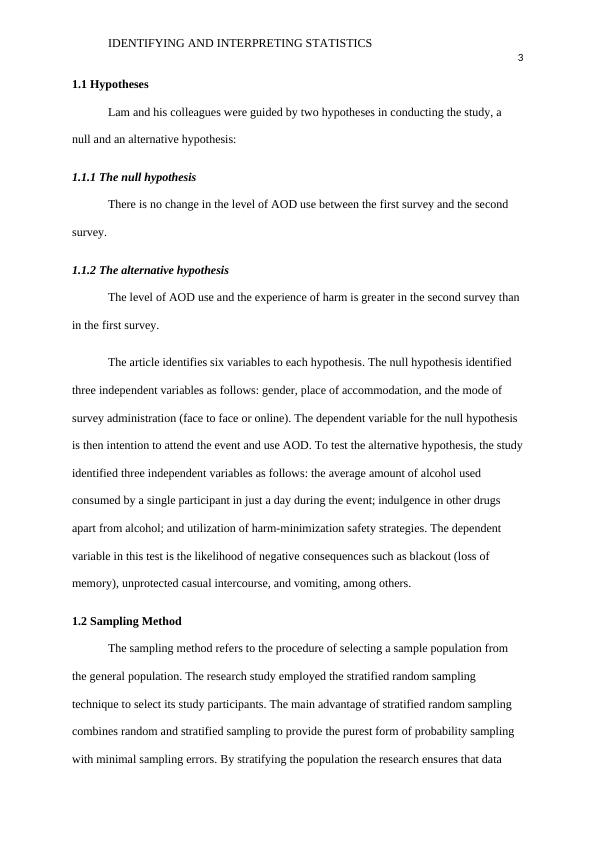Identifying and Interpreting Statistics in Research Articles
Added on 2023-06-13
10 Pages2582 Words162 Views
Running head: IDENTIFYING AND INTERPRETING STATISTCS
1
Identifying and Interpreting Statistics in Research Articles
Name:
Institution:
1
Identifying and Interpreting Statistics in Research Articles
Name:
Institution:

IDENTIFYING AND INTERPRETING STATISTICS
2
Identifying and Interpreting Statistics in Research Articles
Research articles involve statistical methods in studies to describe the fundamental
features of data. The data findings are analyzed, interpreted, and reported to give meaning to
the numbers (Ali & Bhaskar, 2016). Data can either be qualitative or quantitative. This paper
tries to identify and interpret statistical data in two health-related research articles. Article one
is “Alcohol and other drug use at school leavers' celebrations” (Lam, Liang, Chikritzhs, &
Allsop, 2013); and, article two is “The rising tide of diabetes mellitus in a Chinese
population: A population-based household survey on 121,895 persons” (Wong, Leung,
Tsang, Lo, & Griffiths, 2013). It describes the hypothesis, variables, statistical methods, and
study limitations.
Research Article One
1.0 Introduction
Lam, Liang, Chikritzhs, and Allsop (2013) conducted a research to determine the rate
of “alcohol consumption and other drug use at school leavers’ celebrations” after identifying
a gap in research. The research indicates that many adolescents indulge in alcohol and other
drugs (AOD) when they attend celebratory events. The study examined drug use patterns,
influences, and impacts during the final year of study celebration. As such, the study had two
aims which were to: “(i) compare the levels of AOD use at end of school celebration and use
at other peer-based social events and (ii) relate the experience of harms experienced at the
celebrations to levels of use and engagement in harm-minimization strategies” (Lam et al.,
2013).
2
Identifying and Interpreting Statistics in Research Articles
Research articles involve statistical methods in studies to describe the fundamental
features of data. The data findings are analyzed, interpreted, and reported to give meaning to
the numbers (Ali & Bhaskar, 2016). Data can either be qualitative or quantitative. This paper
tries to identify and interpret statistical data in two health-related research articles. Article one
is “Alcohol and other drug use at school leavers' celebrations” (Lam, Liang, Chikritzhs, &
Allsop, 2013); and, article two is “The rising tide of diabetes mellitus in a Chinese
population: A population-based household survey on 121,895 persons” (Wong, Leung,
Tsang, Lo, & Griffiths, 2013). It describes the hypothesis, variables, statistical methods, and
study limitations.
Research Article One
1.0 Introduction
Lam, Liang, Chikritzhs, and Allsop (2013) conducted a research to determine the rate
of “alcohol consumption and other drug use at school leavers’ celebrations” after identifying
a gap in research. The research indicates that many adolescents indulge in alcohol and other
drugs (AOD) when they attend celebratory events. The study examined drug use patterns,
influences, and impacts during the final year of study celebration. As such, the study had two
aims which were to: “(i) compare the levels of AOD use at end of school celebration and use
at other peer-based social events and (ii) relate the experience of harms experienced at the
celebrations to levels of use and engagement in harm-minimization strategies” (Lam et al.,
2013).

IDENTIFYING AND INTERPRETING STATISTICS
3
1.1 Hypotheses
Lam and his colleagues were guided by two hypotheses in conducting the study, a
null and an alternative hypothesis:
1.1.1 The null hypothesis
There is no change in the level of AOD use between the first survey and the second
survey.
1.1.2 The alternative hypothesis
The level of AOD use and the experience of harm is greater in the second survey than
in the first survey.
The article identifies six variables to each hypothesis. The null hypothesis identified
three independent variables as follows: gender, place of accommodation, and the mode of
survey administration (face to face or online). The dependent variable for the null hypothesis
is then intention to attend the event and use AOD. To test the alternative hypothesis, the study
identified three independent variables as follows: the average amount of alcohol used
consumed by a single participant in just a day during the event; indulgence in other drugs
apart from alcohol; and utilization of harm-minimization safety strategies. The dependent
variable in this test is the likelihood of negative consequences such as blackout (loss of
memory), unprotected casual intercourse, and vomiting, among others.
1.2 Sampling Method
The sampling method refers to the procedure of selecting a sample population from
the general population. The research study employed the stratified random sampling
technique to select its study participants. The main advantage of stratified random sampling
combines random and stratified sampling to provide the purest form of probability sampling
with minimal sampling errors. By stratifying the population the research ensures that data
3
1.1 Hypotheses
Lam and his colleagues were guided by two hypotheses in conducting the study, a
null and an alternative hypothesis:
1.1.1 The null hypothesis
There is no change in the level of AOD use between the first survey and the second
survey.
1.1.2 The alternative hypothesis
The level of AOD use and the experience of harm is greater in the second survey than
in the first survey.
The article identifies six variables to each hypothesis. The null hypothesis identified
three independent variables as follows: gender, place of accommodation, and the mode of
survey administration (face to face or online). The dependent variable for the null hypothesis
is then intention to attend the event and use AOD. To test the alternative hypothesis, the study
identified three independent variables as follows: the average amount of alcohol used
consumed by a single participant in just a day during the event; indulgence in other drugs
apart from alcohol; and utilization of harm-minimization safety strategies. The dependent
variable in this test is the likelihood of negative consequences such as blackout (loss of
memory), unprotected casual intercourse, and vomiting, among others.
1.2 Sampling Method
The sampling method refers to the procedure of selecting a sample population from
the general population. The research study employed the stratified random sampling
technique to select its study participants. The main advantage of stratified random sampling
combines random and stratified sampling to provide the purest form of probability sampling
with minimal sampling errors. By stratifying the population the research ensures that data

End of preview
Want to access all the pages? Upload your documents or become a member.
Related Documents
A Critical Analysis of Statistical Approaches in Journal Articleslg...
|11
|2931
|326
IDENTIFICATION AND IMPLEMENTATION OF STATISTICS ANALYSIS 2022lg...
|11
|2636
|20
Elucidation of Statistics in Research Articles 2022lg...
|9
|2654
|34
Assignment for Sociology 2022lg...
|9
|2640
|44
Statistics Paperlg...
|14
|2518
|377
STAT6000: Statistics for Public Healthlg...
|14
|2463
|48